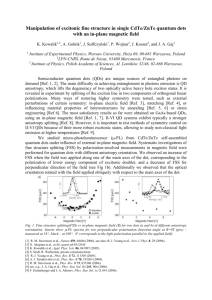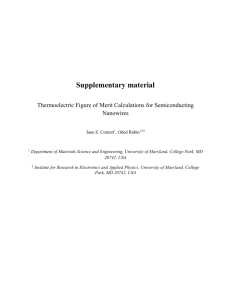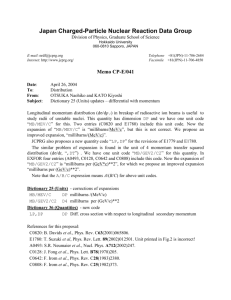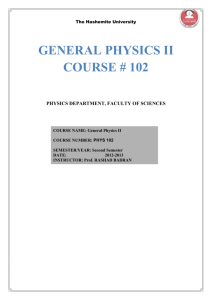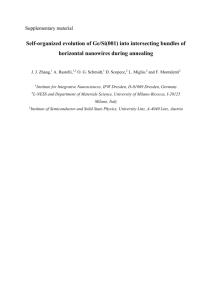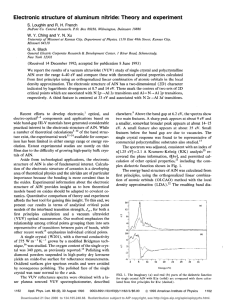Electron-phonon coupling in crystalline Pentacene
advertisement
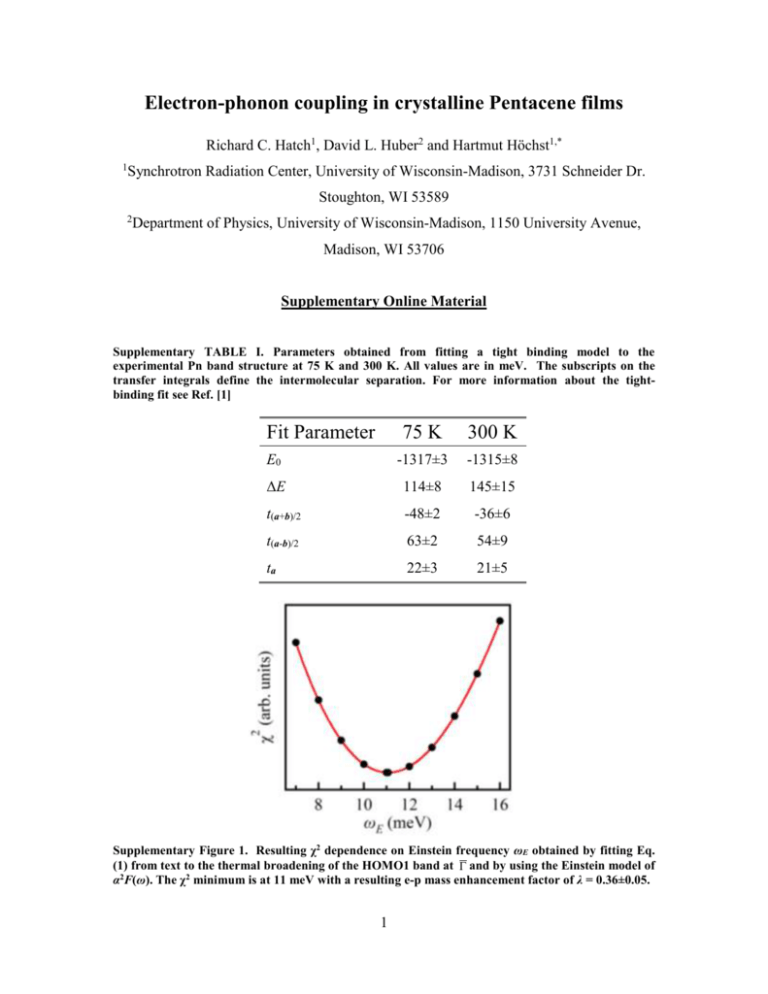
Electron-phonon coupling in crystalline Pentacene films Richard C. Hatch1, David L. Huber2 and Hartmut Höchst1,* 1 Synchrotron Radiation Center, University of Wisconsin-Madison, 3731 Schneider Dr. Stoughton, WI 53589 2 Department of Physics, University of Wisconsin-Madison, 1150 University Avenue, Madison, WI 53706 Supplementary Online Material Supplementary TABLE I. Parameters obtained from fitting a tight binding model to the experimental Pn band structure at 75 K and 300 K. All values are in meV. The subscripts on the transfer integrals define the intermolecular separation. For more information about the tightbinding fit see Ref. [1] Fit Parameter 75 K 300 K E0 -1317±3 -1315±8 ΔE 114±8 145±15 t(a+b)/2 -48±2 -36±6 t(a-b)/2 63±2 54±9 ta 22±3 21±5 Supplementary Figure 1. Resulting χ2 dependence on Einstein frequency ωE obtained by fitting Eq. (1) from text to the thermal broadening of the HOMO1 band at and by using the Einstein model of α2F(ω). The χ2 minimum is at 11 meV with a resulting e-p mass enhancement factor of λ = 0.36±0.05. 1 Determination of effective average phonon energy As explained in Ref. [2] the lattice relaxation energy directly expresses the strength of the Peierls coupling and is defined as E LR G 2j / 2 j where Gj is the total j Peierls coupling constant of mode j, a sum of the modulations of the four main hopping integrals in the ab crystal plane. By symmetry, only totally symmetric (Ag) phonons are appreciably coupled to the charge carriers. Table 2 in Ref. [2] shows the phonons that are coupled to the charge carriers having an energy less than 203 cm-1. Phonons of higher energy are significantly less coupled [2]. From the values listed in Table 2 and from our definition of the effective Einstein energy, eff j Gj Gtot j 1 G j j Gtot j where Gtot is defined as Gtot G j we obtain a value of ωeff = 13.8 meV. This j calculated value for the effective Einstein energy is in excellent agreement with our experimentally determined value of ωE = 11 ± 4 meV. Supplementary Figure 2. Relative Peierls coupling constants for a given phonon mode energy determined from Ref. [2] (green). Also shown is the calculated and experimentally determined effective Einstein energy (black and red respectively). The calculated and experimentally determined values are, within error bars, in excellent agreement. 2 Determination and discussion of the HOMO bandwidth in Pentacene Unlike in PTCDA (Ref. [3]), a solid with one molecule per unit cell, the two inequivalent molecules per Pn unit cell give rise to two HOMO-derived Pn bands which we call HOMO1 and HOMO2. To see how these two bands manifest themselves in photoemission spectra see Fig. 1(d) of the current work and to see how the band dispersions are revealed using angle-resolved photoemission spectroscopy see Ref. [1]. These two bands are predicted by theory [4-8] and have been measured experimentally [1, 9], are separated by ~500 meV and are periodic in symmetry directions. Any determination of the Pn band dispersions and subsequently, the HOMO bandwidth, must consider and distinguish the two bands unlike the work of N. Koch et al. [10] where the Pn HOMO feature is treated with a single band. The definition of the HOMO bandwidth (HBW) is the energy difference between the maximum of HOMO1 and the minimum of HOMO2, and as shown by theory and experiment is ~500 meV [1, 4-9]. In a previous work [1] we determined that the HOMO1 maximum and the HOMO2 minimum coincided at M . In the current work we report (Fig. 3(d)) our determination of the Pn band structure around M at 75 K and 300 K. The 2σ confidence bands (also shown in Fig. 3(d)) are either distinctly separated (for the HOMO1 band) or barely touch (for the HOMO2 band). This error analysis shows that the reported temperature dependent HBW is of statistical significance and we report a HBW narrowing of 15 ± 8%. 3 *Corresponding Author: hhochst@wisc.edu [1] R. C. Hatch, D. L. Huber, and H. Höchst, Phys. Rev. B 80, 081411 (2009). [2] A. Girlando, M. Masino, A. Brillante et al., Materials Science-Poland 22, 307 (2004). [3] G. N. Gavrila, H. Mendez, T. U. Kampen et al., Appl. Phys. Lett. 85, 4657 (2004). [4] G. A. de Wijs, C. C. Mattheus, R. A. de Groot et al., Synth. Met. 139, 109 (2003). [5] H. Yoshida, and N. Sato, Phys. Rev. B 77, 235205 (2008). [6] A. Troisi, and G. Orlandi, J. Phys. Chem. B 109, 1849 (2005). [7] K. Hummer, and C. Ambrosch-Draxl, Phys. Rev. B 72, 205205 (2005). [8] P. Parisse, L. Ottaviano, B. Delley et al., J. Phys.: Condens. Matter 19, 106209 (10pp) (2007). [9] O. Manabu, S. Tadamasa, S. Toshihiro et al., Appl. Phys. Lett. 95, 123308 (2009). [10] N. Koch, A. Vollmer, I. Salzmann et al., Phys. Rev. Lett. 96, 156803 (2006). 4
